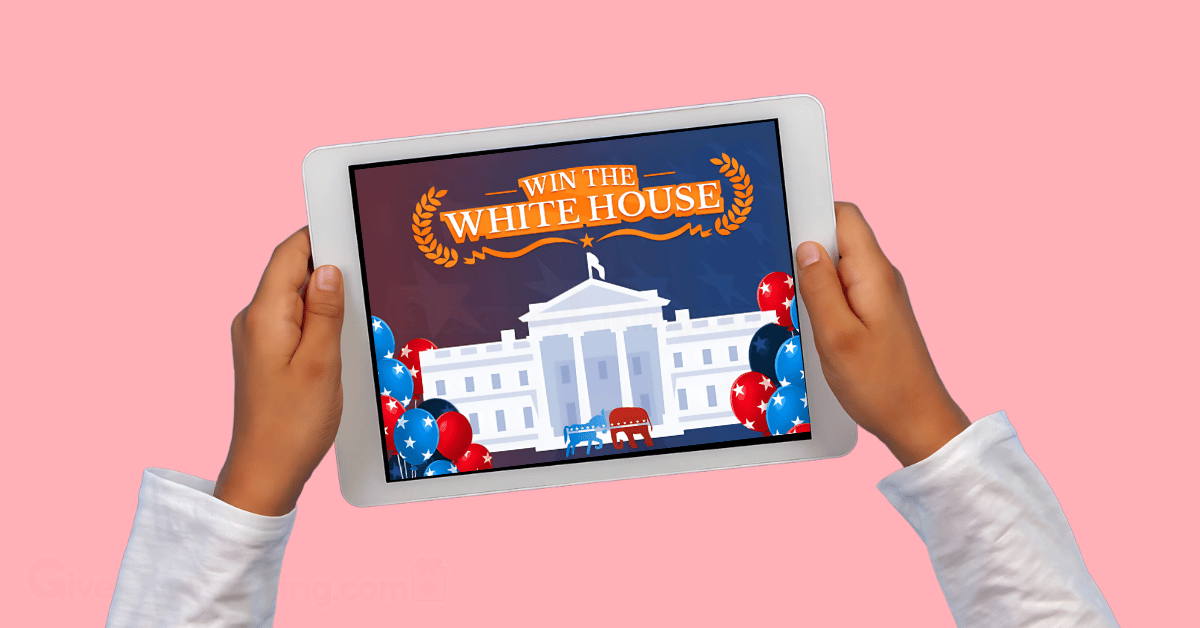Win the White House Gameplay: A Thorough Guide
Future campaign strategists and Commanders-in-Chief! Let’s break down iCivics’s educating game, ‘Win the White House. ‘ This is an interactive crash course in running for the highest office in the USA. You’ll step into the shoes of a presidential candidate, building your platform, raising funds, hitting the campaign trail, polling voters, and navigating the all-important, sometimes baffling, Electoral College.
This guide contains the newest intel as of December 2025, designed to give you the edge. We’ll cover the essential ‘6 tips to ace iCivics’ Win the White House game’, explore the game’s key facts and more.
Win the White House Game Key Facts as of December 2025
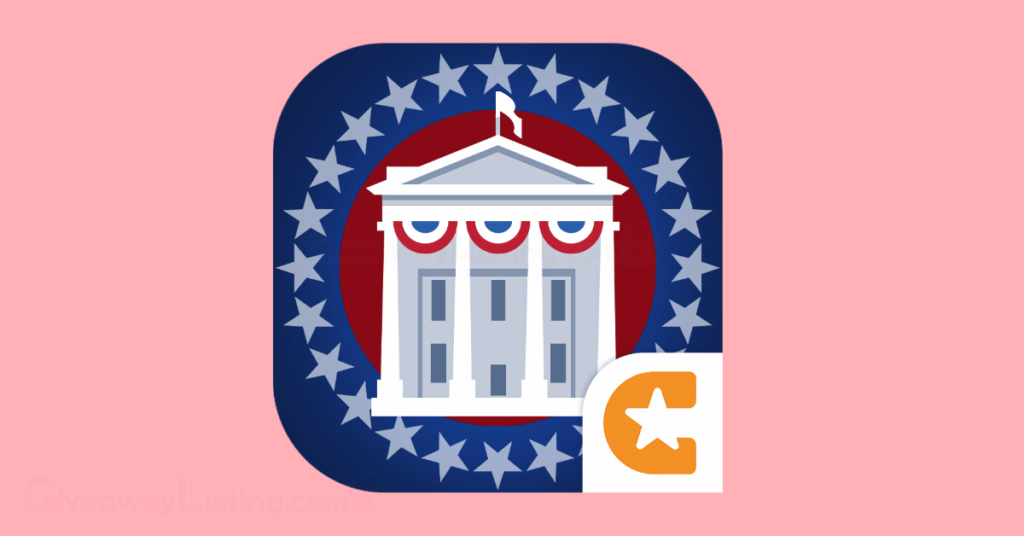
From the magic electoral vote count to millions of plays, here’s a statistical report of the ‘Win the White House’ experience:
- To claim victory in the game, a presidential candidate must capture precisely 270 Electoral Votes.
- The intense general election campaign unfolds over a 10–week timeframe within the game.
- As of early 2024, ‘Win the White House’ has been engaged with over 20 million times via iCivics.org.
- A typical playthrough requires 30+ minutes, making it suitable for a standard class session.
- Candidates typically define their platform by selecting 5 key issues during the primary debates or 4 from their chosen party plus 1 “maverick” issue from the opposition.
- iCivics thoughtfully offers game versions tailored for students across grades 4 through 12.
- The game is accessible on web browsers and via dedicated apps for iOS and Android. The app’s last update was around May 31, 2024.
6 Tips to Ace iCivics’ Win the White House Game
Created by the non-profit iCivics, the Win the White House game isn’t just about clicking buttons – it’s a simulation that puts you in charge of a presidential campaign. You get to build your candidate from the ground up
It’s all about making smart choices to reach 270 electoral votes before Election Day. Much like figuring out the tactics in other strategy challenges, understanding the core mechanics here is key to success in this game.
1. Pay Attention During the Primaries
Think of the first part of the game – the primaries – as your campaign school. This is where you learn how everything works before the big race. The game guides you through campaigning in early Iowa and New Hampshire states. Don’t rush through this! Take time to understand how much things cost – like running an ad or polling voters – in terms of money and campaign weeks.
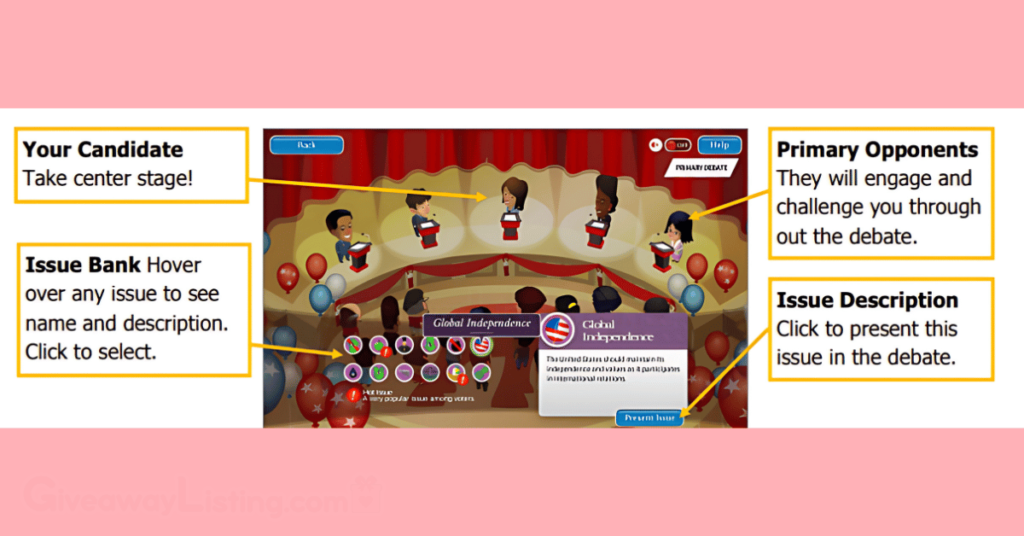
The debates here are super important, too. You pick issues you care about but must choose the best way to talk about them. Get it right, and that issue becomes part of your campaign strength. Get it wrong, and your opponent might snag it! This practice helps you learn which arguments work best.
Learning how to spend your time and money wisely during these primaries sets you up for success later. It’s like practicing drills before a big sports game. The primaries are basically the tutorial – so soak up all the knowledge you can.
2. Know Your Electoral College Map
To win this game, you need 270 Electoral Votes (EVs). Each state has a specific number of EVs, mostly based on its population. Winning California gives you way more EVs than winning Montana.
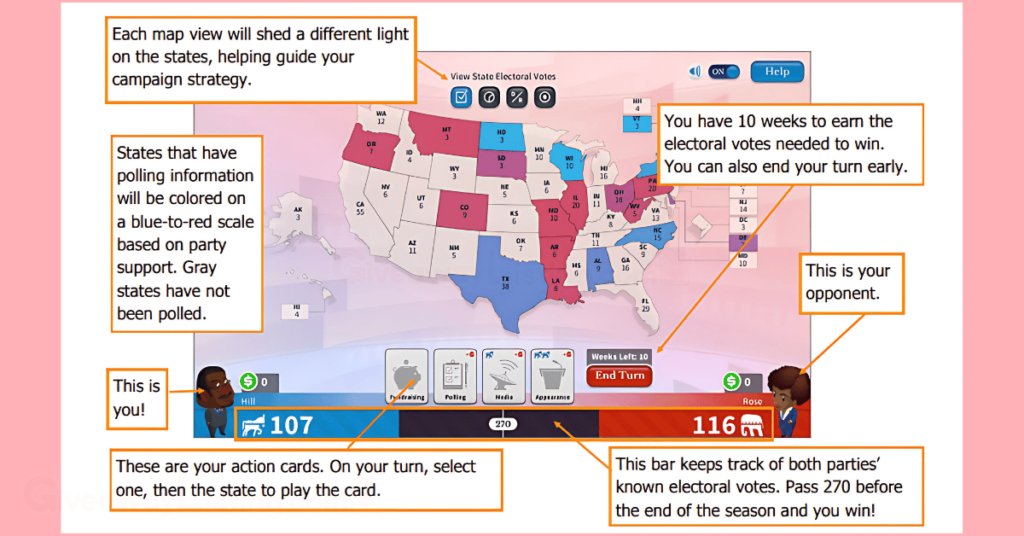
This means you need to live by the map. The game gives you tools. Check the buttons at the top of the map screen to see how many EVs each state has, who’s leading in the polls there, and which way the “momentum” is swinging. Are people leaning towards you or your opponent? Where can you raise money?
You should focus your energy on states that give you the most EVs for your effort. Big states are important, but so are “battleground” states – where the race is close. Don’t waste all your time and money campaigning in a state you’re already winning easily or one where your opponent is way ahead. Think smart.
3. Raise Money Where it Counts
Running for president costs a lot of virtual money! You need cash to poll voters, run TV and online ads, and travel for campaign stops. Without money, your campaign grinds to a halt. So, fundraising is key. But don’t just ask for money anywhere.
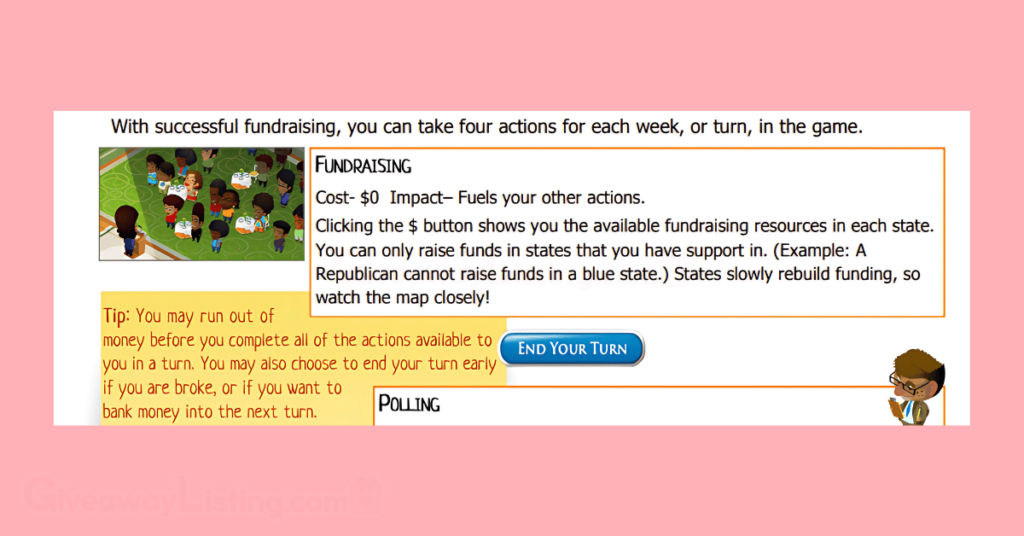
The game rewards smart fundraising. The best places to raise money are states where you are already popular or have good momentum. Check your map filters. If a state is leaning heavily towards your opponent, trying to fundraise there is probably a waste of a precious campaign week. Focus your efforts on states that are friendly to your campaign.
You constantly have to decide: spend a week raising money or spend it campaigning? Finding the right balance is tricky. You don’t want to run out of cash, but you also don’t want to sit on a pile of money while your opponent wins votes. Look for friendly states that still have funds available and target them. Smart fundraising keeps your campaign engine running.
4. Use Polls to Guide Your Moves
Imagine trying to campaign with a blindfold on – that’s what it’s like without polling! Polls are how you figure out what’s happening in each state. They tell you which issues voters care about most, whether they like you or your opponent, and if your campaign is gaining energy. Don’t guess what voters want – poll them!
5. Master Your Message For Media & Appearances
Once you know where to campaign and what voters care about, you must get your message out. Your main tools are media campaigns and personal appearances. They work differently, so use them strategically.
Media campaigns are suitable for reaching lots of people across a whole state. Use them to push a popular issue or gain ground in a big state. Personal appearances are better for creating excitement in a specific area, helping you build momentum directly with voters. Sometimes, you might even run “negative ads” that point out your opponent’s weaknesses – it’s all part of the campaign strategy!
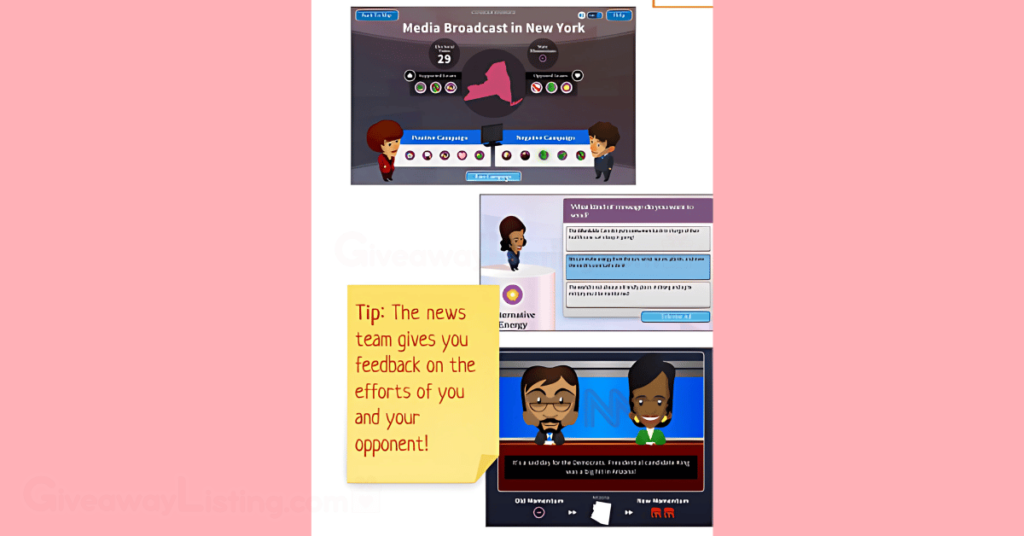
Based on your polls, use these tools together. If you’re trying to win over undecided voters in a swing state, maybe a big media campaign is the answer. If you need to fire up your supporters, maybe a personal appearance is better. Effectively communicating your positions using media and appearances is how you build momentum and win votes.
6. Keep the Momentum Going & Be Ready to Change Plans
Momentum is like the energy level of your campaign in each state. When you have high momentum, you’re likely gaining support. If it drops, you might be losing ground. Winning the game is all about building and keeping momentum, especially in those close battleground states.
But momentum can change fast! Your opponent is also campaigning, trying to build their own momentum. You have to keep watching the map filters every week. Are you gaining or losing energy in key states? Don’t assume a state is won just because you were leading there last week. Your opponent might be making a comeback!
This means you need to be flexible. Your awesome plan might need to change if your opponent makes a surprise move or if polls shift. Maybe you suddenly need to defend a state you thought was safe. Maybe you need to spend an extra week fundraising. Be ready to adapt your strategy based on what’s happening in the race. Staying alert and flexible is key to crossing the finish line with 270 EVs!
Is There a Certificate for Win the White House Game?
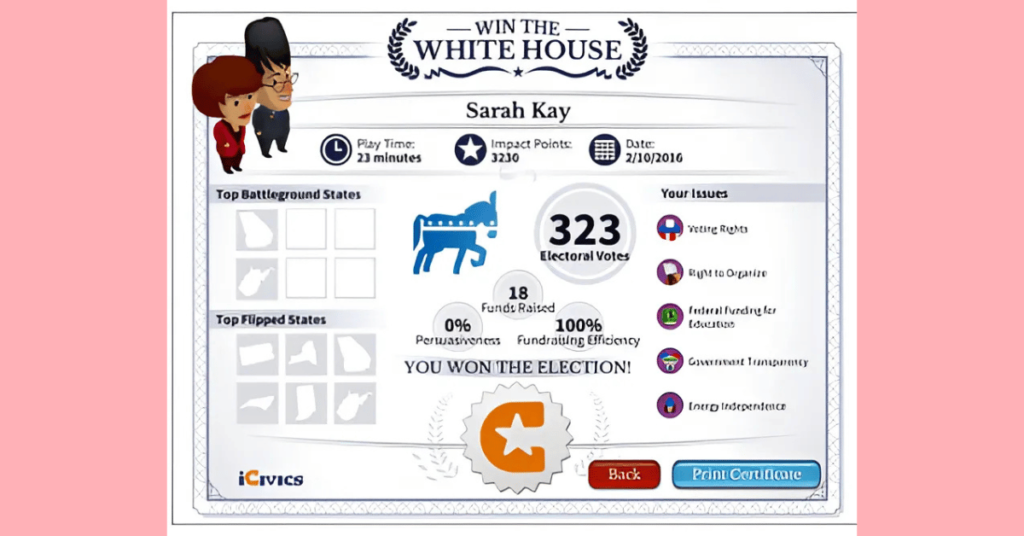
After going through the challenging path of the presidential campaign in ‘Win the White House,’ the game rewards your efforts by providing a printable certificate. This serves as your official campaign after-action report, capturing the highlights and lowlights of your run for the presidency.
This certificate is more than just a participation trophy; it’s a data-packed summary of your strategic decisions and their outcomes. Based on game guides and reviews, it typically includes your final electoral vote count, identifies the battleground states in your election, potentially shows which states flipped allegiances, lists the issues you championed, and more information.
It’s a brilliant feature for consolidating the learning experience. Especially in educational settings, these certificates allow students to easily share and compare their results. Teachers can leverage them to spark discussions about why certain strategies worked better than others, the impact of focusing on different states, or the effectiveness of particular issue platforms. Did chasing those big state EVs pay off, or was focusing on smaller battlegrounds the winning ticket? The certificate provides the data to analyze these questions.
So, while it’s not a formal academic transcript, this printable certificate acts as a valuable, personalized record of your gameplay. It clearly shows your unique campaign narrative, making the abstract concepts of electoral strategy and the Electoral College more concrete and memorable.
The Win the White House Answer Key

If you’re searching for a magic list of answers that guarantees a win within the game itself, you won’t find one. That’s because ‘Win the White House’ is a simulation based on strategy and dynamic choices – campaign effectiveness depends on how well you manage funds, target states, respond to polls, and utilize media, not on reciting predefined answers. There’s no single “right” way to play or win every time.
However, the term “answer key” is part of the supplemental educational materials iCivics provides alongside the game, specifically within the Win the White House Extension Pack. This pack contains resources like detailed lesson plans, student activity sheets, engaging Google Slides, and a mini-quiz or assessment.
These answer keys are designed to help teachers assess student understanding of the core civics concepts the game aims to teach, such as the mechanics of the Electoral College, the role of campaign finance, media influence, primary vs. general elections, and the importance of different states in campaign strategy.
They provide a quick way to check comprehension after students have engaged with the game, ensuring the learning objectives were met. Teachers can find these Extension Packs and the associated answer keys typically by creating a free educator account on the iCivics website, which unlocks comprehensive educational resources for their games.
Win the White House Mini Quiz
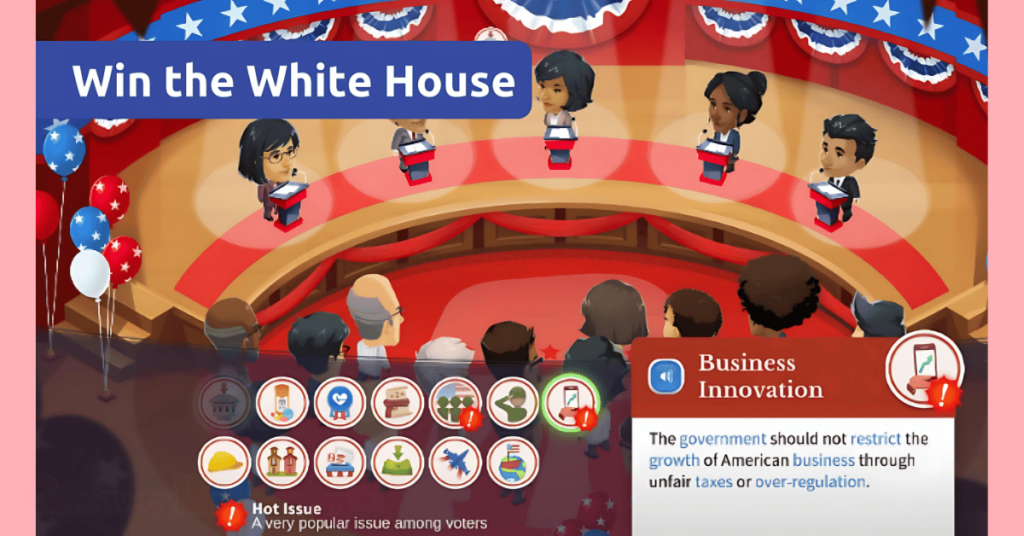
For educators and super keen students, iCivics offers a mini-quiz as part of the official Win the White House Extension Pack. This pack is like the game’s companion guide, with extra resources to deepen the learning. The quiz isn’t designed to test if you won the game but rather to check if you understood the key civics concepts presented through the game.
These concepts include understanding the Electoral College, the difference between primary and general elections, the influence of media, and the role of fundraising and polling – basically, all the important stuff the game simulates. You can typically find this Extension Pack, which includes the mini-quiz and its answer key.
Learning the Win The White House Game Through BrainPOP
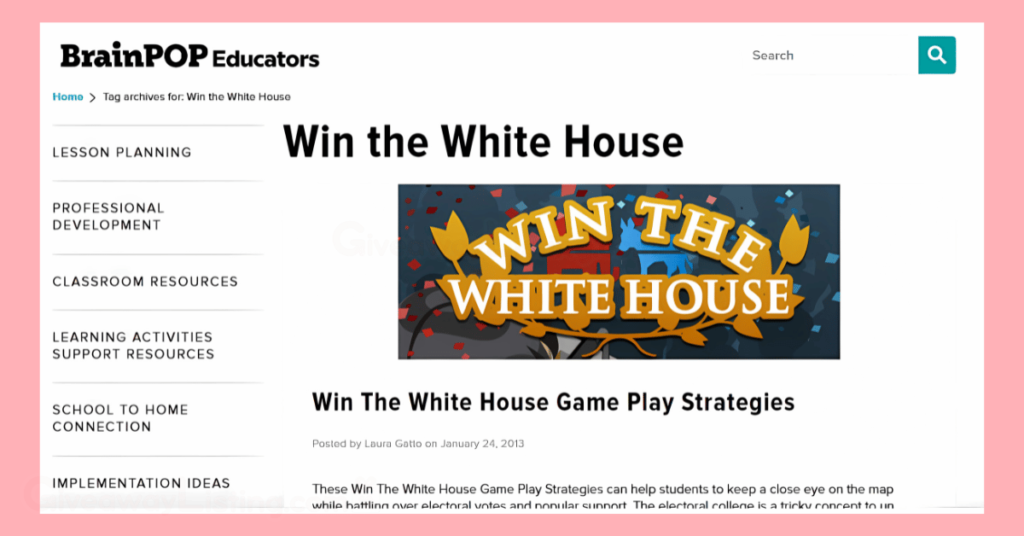
BrainPOP is a super-popular educational resource known for its engaging animated movies, quizzes, and learning activities covering various subjects. They’re masters at making complex topics understandable and, dare we say, fun! BrainPOP often partners with other top-notch educational creators to bring even more awesome content to students and teachers.
One of those partnerships is with iCivics, which means you can find and play ‘Win the White House’ directly through BrainPOP’s GameUp section. But BrainPOP doesn’t just host the game; they provide a whole support ecosystem. It has the game plus a bunch of helpful explainers and strategy guides, all in one place. It’s a great way to integrate gameplay with more structured learning content found on some educational game platforms.
BrainPOP Educators’ dedicated teacher portal offers specific resources for ‘Win the White House. You can find teaching tips that provide strategies for gameplay, helping students understand tricky concepts like the Electoral College and managing campaign resources effectively.
Furthermore, BrainPOP often links games like ‘Win the White House’ to their relevant animated movies. For instance, students could watch BrainPOP’s movie about Presidential Elections or Political Parties and then jump into the game to apply what they’ve learned in a practical simulation. This combination of watching, learning, and doing through the game makes the concepts stick much better. BrainPOP effectively uses the game as an interactive tool to reinforce the lessons taught in their other content formats.
Where to Find the Win the White House Activity Cheat Sheet?
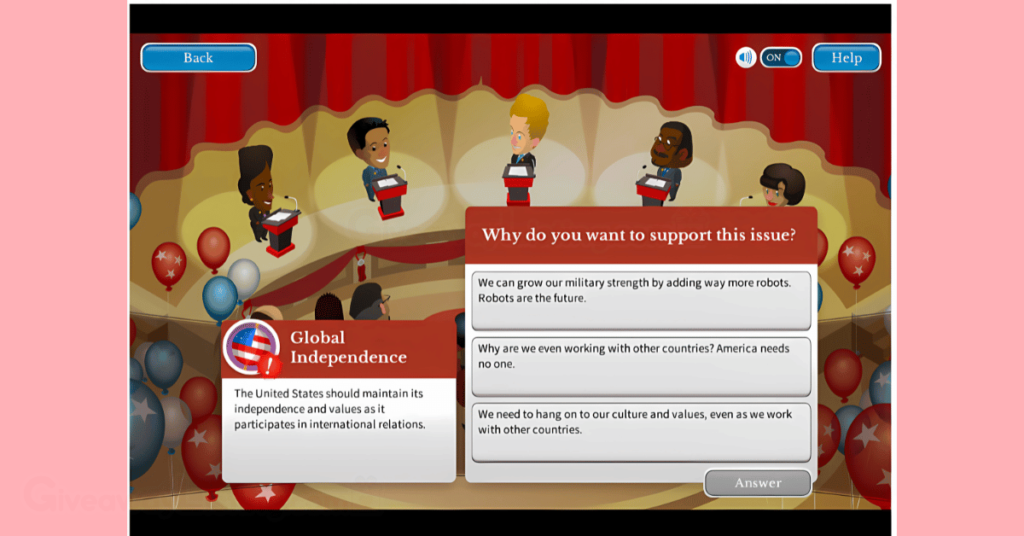
Are you looking for a magic “cheat sheet” or strategy guide that guarantees victory in ‘Win the White House’? If so, the short answer is no, not really. The game isn’t built around secret codes or exploitable glitches. Its purpose is to simulate the strategic decision-making involved in a real presidential campaign. Success hinges on understanding the Electoral College, managing resources wisely, adapting to polling data, and choosing where and how to campaign.
However, the iCivics Activity Cheat Sheet sometimes circulates among educators. This isn’t a cheat sheet for winning the game but a quick reference guide summarizing various iCivics games. It’s a handy tool for teachers planning lessons across multiple iCivics offerings, but it won’t give you specific strategic advantages within the game itself. Finding this specific document, which we have provided above, usually relies on shared resources within teaching communities or through iCivics’ educator resource portals if they officially distribute such a summary document.
Win the White House Gameplay: Closing Remarks
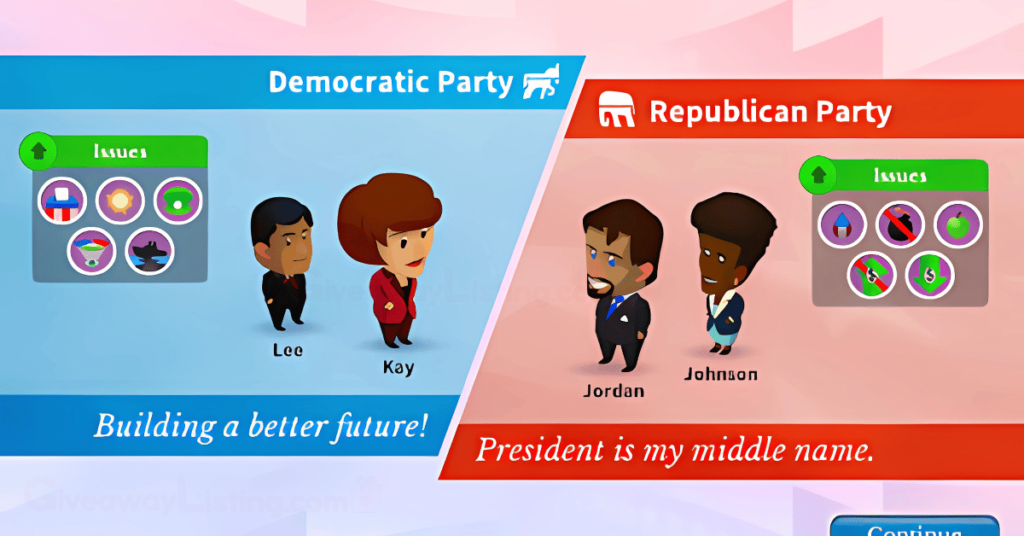
We’ve covered everything from the ‘6 tips to ace iCivics’ Win the White House game’ and key facts about gameplay and certificates to understanding the role of the ‘Win the White House answer key’ and ‘mini quiz,’ learning through BrainPOP resources, and everything else you should know.
It’s clear this isn’t just a game; it’s a dynamic learning experience designed to make civics engaging and understandable, mirroring the strategic depth found in many complex simulation games.
Here’s a quick recap of some key takeaways:
- Victory requires securing exactly 270 Electoral Votes.
- The game simulates a 10-week general election campaign.
- It has been played over 20 million times on iCivics.org.
- A printable certificate summarizes your campaign performance upon completion.
- The primary season cleverly doubles as the game’s tutorial.
- Resources like Extension Packs with quizzes and BrainPOP integrations enhance learning.
- The game is available in Spanish and has accessibility features.
- Gameplay duration is typically 30+ minutes, suitable for class periods.
This information is current as of our last update in December 2025.

